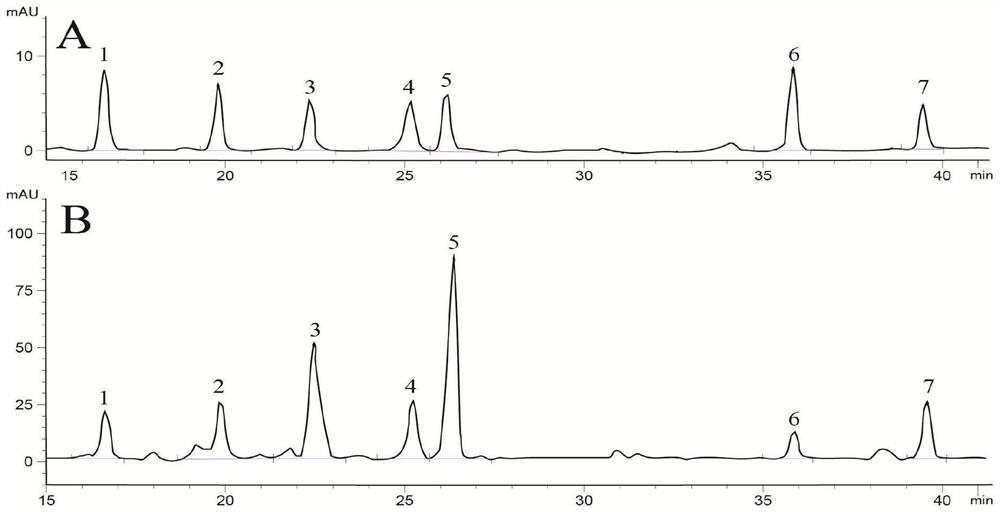HPLC method for detecting saponin in panax notoginseng leaves
A technology of notoginseng saponin and notoginseng leaf, which is applied in the medical field and can solve the problems of less types of notoginseng saponin monomers and lagging detection methods
- Summary
- Abstract
- Description
- Claims
- Application Information
AI Technical Summary
Problems solved by technology
Method used
Image
Examples
Embodiment 1
[0032] A HPLC method for detecting saponins from Panax notoginseng leaves, characterized in that it comprises the steps of:
[0033]Step (1), preparation of the test sample solution: dry the leaves of Panax notoginseng in time after harvesting at a temperature of 55°C, grind them into powder, pass through a 45-mesh sieve, and the sieved Panax notoginseng powder Add chloroform, let it stand overnight for 10 hours, filter, discard the supernatant, take the precipitate, add chloroform after the precipitate has dried naturally, filter again after standing for 2 hours, take the precipitate, wait for the precipitate to dry naturally, take the air-dried powder and add Methanol, stand still for 30 minutes, then ultrasonically extract for 20 minutes, let stand for 1 hour, let it cool down to room temperature, finally use methanol for precise quantification, shake slowly, take the liquid after standing for 30 minutes, and filter it with a 0.45 micron filter membrane to obtain the test so...
Embodiment 2
[0039] A HPLC method for detecting saponins from Panax notoginseng leaves, characterized in that it comprises the steps of:
[0040] Step (1), preparation of the test sample solution: dry the leaves of Notoginseng leaves in time after harvesting at a temperature of 60°C, grind them into powder, pass through a 45-mesh sieve, and add the leaves of Notoginseng leaves under the sieve Chloroform, stand overnight for 12 hours, filter, discard the supernatant, take the precipitate, add chloroform after the precipitate has dried naturally, filter again after standing for 3 hours, take the precipitate, wait for the precipitate to dry naturally, take the air-dried powder and add methanol After resting for 40 minutes, ultrasonically extract for 30 minutes, let it stand for 2 hours, let it cool to room temperature, and finally use methanol for precise quantification, shake slowly, and after standing for 40 minutes, take the liquid and filter it with a 0.45 micron filter membrane to obtain ...
Embodiment 3
[0055] A HPLC method for detecting saponins from Panax notoginseng leaves, characterized in that it comprises the steps of:
[0056] Step (1), preparation of the test sample solution: dry the notoginseng leaves in time after harvesting at a temperature of 58°C, grind them into powder, pass through a 45-mesh sieve, and accurately weigh the sieved notoginseng Put 1g of leaf powder in a 50ml Erlenmeyer flask, add 50ml of chloroform, let it stand overnight, filter the solution with filter paper the next day, remove the filtrate, take the precipitate on the filter paper, and after the precipitate is naturally air-dried, add it to 30ml of chloroform again, and let it stand for 2.5 After h, filter again with filter paper, and let the precipitate dry naturally; then take 0.6g of powder and add 50ml of methanol, stand still for 35min, then ultrasonically extract for 25min, let stand for 1.5h, let it cool to room temperature, and finally use methanol to precisely quantify to 50ml, shake ...
PUM
 Login to View More
Login to View More Abstract
Description
Claims
Application Information
 Login to View More
Login to View More - R&D
- Intellectual Property
- Life Sciences
- Materials
- Tech Scout
- Unparalleled Data Quality
- Higher Quality Content
- 60% Fewer Hallucinations
Browse by: Latest US Patents, China's latest patents, Technical Efficacy Thesaurus, Application Domain, Technology Topic, Popular Technical Reports.
© 2025 PatSnap. All rights reserved.Legal|Privacy policy|Modern Slavery Act Transparency Statement|Sitemap|About US| Contact US: help@patsnap.com



